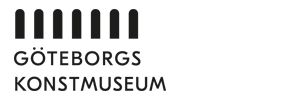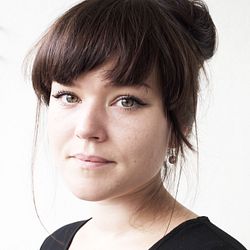Pressmeddelande -
The photographic image, teenage life and identity in focus when Julia Peirone exhibits at the Gothenburg Museum of Art
Julia Peirone is one of the most interesting Nordic artists today. Since her debut at the turn of the century 2000, Peirone has explored identity and the photographic image, often with a focus on young women, in series that mirror aspects of vulnerability, shame and sexuality connected to childhood and the transition to adulthood. It is a great honour for the Gothenburg Museum of Art to present Julia Peirone’s first major museum exhibition comprising around one hundred works, both newly produced works and loans from private collections, in the media of photography, video and sculpture, among others.
For almost twenty years, Julia Peirone has worked with the theme of “the girl”, from the outset depicted by drawing a contour on old postcards with a white pen. Sometimes, the contours of two figures emerge, indicating early self-portraits. In the beginning, “the girl” signaled being an outsider, but over time this has evolved into contexts in which she increasingly controls given situations. This can be understood as a way of problematising norms and preconceptions about the roles of girls in society.
Today, we meet a well-established artistic oeuvre that poses questions about what a photographic image can be and what it can do, what its strengths and limitations are. Above all, Julia Peirone is interested in how reality exists through the image and how we encounter ourselves in images.
This is about appearances and reflections, how memories and fantasies, demands and desires, shame and seduction blend into each other. In an age that is heavily influenced by social media and a visual culture that not seldom is used to create identity and shape the person one wants to be, the uncontrollable and vulnerable become important themes. And the gap between the world and our thoughts about the world.
-Julia Peirone is an artist who transcends genres, and comes close to her models, meeting teenagers who are in the midst of the complexity of puberty – still children, but striving towards adulthood. In an era that demands more and more of young girls, the artist does not shy from the dark and difficult questions in her portrayal of “the girl”. Here, the models are given a platform and a secure environment where they can explore themselves on their own terms, says curator Camilla Påhlsson.
Investigating norms, mental states and imagery
In several respects, the work of Julia Peirone has a proximity to the moving image. In her photographic series, she often works with the casting situation and preparations, in which retakes, fleeting moments and failures are given a prominent position. They can hardly be defined as portraits in the conventional sense; rather, they investigate mental states and visual conventions in conjunction with social norms that reflect the demands of the external world, not least in the divide between intention and action, such as in the series Twisted Cherry (2016).
Other captivating aspects of Julia Peirone’s work are a visual idiom that embodies a resistance to narrative continuity, and her ambiguous and fascinating titles, in which the constellations of words and their poetic tone creates a dialogue with the image, as in the video work Waiting for Red Pigtails (2004-2008). Several of the titles stem from the names of make-up products or cocktails and their glamorous aura is full of promises, for instance in the work Golden Me (2016). Words that are connected to the photographs steer the viewer’s gaze and also affect how the image is perceived and interpreted.
Challenging the relationship between the viewer and the viewed
Many of Julia Peirone’s images have a common denominator in that they explore the relationship between the photographer and the model, as well as between the viewer and the viewed. The viewer seldom meets the gaze of person in the portrait. Often, the model has her eyes shut, or faces another direction; alternatively, the face is hidden behind a swathe of hair, such as in More than Violet (2010-2012). However, the skin is exposed, an aspect that is reinforced by the clothes that the girls wear: tight tank-tops, and short skirts or shorts.
The way in which the motifs appear in Peirone’s works challenges the relationship between subject and object. At the same time, Julia Peirone stresses that “the girls in my pictures are victims of a gaze, but they are also strong and have power over your gaze”. It is also crucial for the interpretation of the image whether the photographer is a man or a woman.
The exhibition presents new works and is accompanied by a catalogue
The exhibition Girls, Girls, Girls presents new works by Julia Peirone to the public for the first time. Among them is the series Diamonds Dancing (2017), which includes references to classical sculpture and Renaissance painting, characterized by how light flowing from dark and murky colours creates a religious atmosphere. As part of the process of increasing the knowledge about artists who are represented in the museum’s collection, the exhibition is accompanied by a richly illustrated catalogue.
The exhibition was produced by the Gothenburg Museum of Art in collaboration with the artist’s gallery, Belenius, and private lenders. After the première at the Gothenburg Museum of Art, the exhibition continues to the Kalmar Museum of Art.
Biography
Julia Peirone (b 1973) was born in Argentina but grew up in Lund, Sweden. She trained at the Valand Academy in Gothenburg, and at the University College for Arts, Crafts and Design in Stockholm, where she also lives and works. In 2015, she had a solo exhibition at the Anna Nordlander Museum, in 2009 at Linköping’s Art Hall, and in the same year at the Uppsala Museum of Art. She has exhibited at Moderna Museet (2017), the Borås Museum of Art (2016), Artipelag (2014), the Centre for Photography (2011), and Bildmuseet (2005).
Julia Peirone is represented at Kiasma in Finland, Stenersen Museet in Norway, Statens Konstråd, Moderna Museet and the Gothenburg Museum of Art (among other institutions). Peirone has produced a number of publications, such as Waiting for Red Pigtails (Sailor Press, 2013), More than Violet (Art & Theory, 2012), Contemporary Swedish Photography (Art & Theory, 2012), Konstnärer och deras ateljéer [Artists and Their Studios] (Bladh by Bladh, 2012) and Blind Smek Min Kind [Blind Caress My Cheek] (Ordfront/Galago, 2002).
Press preview
Welcome to the press preview Thursday, November 2, 11 am
Acting Museum Director Anna Hyltze gives a welcome speech
Curator Camilla Påhlsson presents the exhibition
The artist will be present at the press preview
Kindly inform us of your participation at the latest Wednesday, November 1 by getting in touch with Helene Karlsson, Communicator
+46 31-368 35 07, Helene.Karlsson@kultur.goteborg.se
Opening
Welcome to the opening Saturday, November 4, 2 pm
Contact
Helene Karlsson, Communicator
+46 31 368 35 07, helene.Karlsson@kultur.goteborg.se
Camilla Påhlsson, Curator
+46 31 368 32 38, camilla.pahlsson@kultur.goteborg.se
Anna Hyltze, Acting Museum Director
+46 31 368 35 20, anna.hyltze@kultur.goteborg.se
Ämnen
The Gothenburg Museum of Art has one of the foremost art collections in Northern Europe. Works by masters such as Rembrandt, Picasso and van Gogh are shown side by side with works by contemporary artists such as Charlotte Gyllenhammar, Klara Kristalova and Cajsa von Zeipel.
The collection includes primarily Western art from the 15th century until today, with an emphasis on Nordic art. In particular, the section containing Nordic art from around the turn of the century 1900 is unique of its kind.
With an internationally renowned collection, a solid exhibition program, in-depth research and a broad selection of educational activities, the Gothenburg Museum of Art is one of Northern Europe’s finest museums for visual art.

